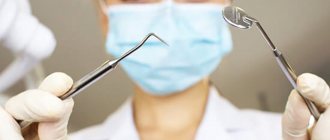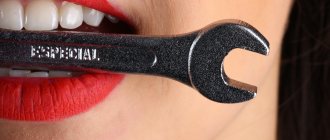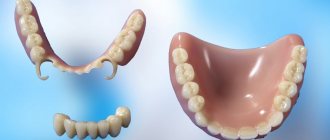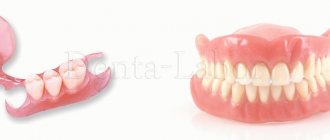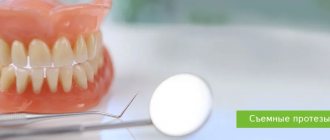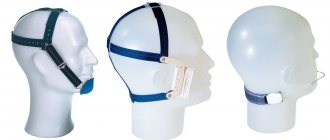Author: Brodsky Sergey Evgenievich Deputy Chief Physician, Candidate of Medical Sciences in the specialties: dentistry and medical microbiology What to do if there is a smell under a dental bridge, a tooth is broken or a bridge has fallen off, how to glue a dental bridge? Read on..
How is a dental bridge installed?
After deciding on bridge prosthetics, the dentist, at the very end of the work, must secure the dental bridge to the supports using glass ionomer cement or fixing screws. In dentistry, there are left and right, anterior and posterior supporting elements for bridges. The support can be either your own teeth or implants. As a rule, the left, right, anterior and posterior reference points are the same: these are either teeth or implants. Experienced prosthetists do not recommend installing and replacing dental bridges on mixed elements:
- in front is a tooth;
- behind - an implant or vice versa.
Patients often ask: “Why does a dental bridge fall out?” In the next paragraph we will tell you what to do if the bridge is loose in your mouth. How a bridge is attached to teeth or implants, photo.
Just CALL US!
+7
We will answer any of your questions and will definitely help you!
Why does a dental bridge wobble?
So, if a bridge made of cermet, zirconium, plastic or metal is shaking, the reasons for this are:
- Falling out or peeling off of the dental core tab or loosening of the fixing screw in the implant;
- Destruction of the anterior or posterior or (both) supports, no matter the tooth or implant;
- Atrophy of bone tissue and exposure of the gums around the root of the abutment tooth or the intraosseous part of the implant;
- Trauma (strike or fall);
- Incorrect load on the prosthetic structure, overestimation or underestimation of the bite (doctor’s error);
- Bruxism and hypertonicity of the masticatory muscles;
- Hormonal and systemic diseases of the body.
Thus, if the dental bridge begins to wobble, you should immediately consult a dentist. Timely removal of dental bridges in some cases allows you to save the supports on which it is attached and re-glue the dental bridge, both new and old.
If a dental bridge breaks and falls off
In this section we will look at a sad situation where a dental bridge broke and flew off. To better understand this sad fact, it is first necessary to note some generally accepted facts:
- from the point of view of the further use of the old bridge, it is absolutely not important what material the structure was made of: a bridge made of metal-ceramic or zirconium, metal or composite fell out, if this happened, it means either the dental bridge burst, or a tooth or implant broke under the dental bridge, and this requires either strengthening old ones or creating new supporting elements, as well as a new fixed prosthesis.
- any bridge prosthetics has a shelf life (for example: metal-ceramics lasts 10-12 years, stamped-soldered metal 6-8 years, acrylic plastics up to 2 years, composite up to 3-4 years, zirconium up to 15-20 years), respectively, by asking When asking a doctor whether dental bridges are being put back in place, it is necessary to take into account the time factor of their operation.
Most often, the main reason that a dental bridge is wobbly and painful is the mobility and destruction of either supporting teeth, or atrophy of the bone tissue where the tooth roots are fixed. Thus, the question of how to glue the fallen bridge loses its relevance, because the manufacture of a new structure is required.
Reasons why a dental bridge may fall off
The integrity of the dental bridge is influenced by the following factors:
- The bridge was made to inaccurate measurements. Dentists believe that a bridge can only be made for five crowns and no more, otherwise the bridge design becomes unreliable.
- If the neighboring teeth that support the bridge are poorly prepared for prosthetics, this can also cause the bridge to fly off.
- Crowns for supporting teeth must be made of high-quality material, and they must be fixed with high-quality dental cement.
- Improper oral and dental hygiene. To keep your artificial teeth clean, you should have your teeth professionally cleaned twice a year. If this is not done, the period of wearing dentures will be greatly reduced.
Which bridge material to choose
Metal prostheses are a thing of the past; they have been replaced by progressive designs made from modern materials. Anyone can put a bridge on their teeth, taking into account price and functionality. I suggest installing bridges with segments from 3 to 5 teeth
(now we are not talking about total prosthetics during implantation):
Metal-ceramic bridges
Solid versions will be made by specialists in the laboratory using an impression, taking into account all anatomical features. Layers of ceramics are applied to the crowns by hand and baked at high temperatures. Such bridges are durable and belong to an affordable price category. They are often chosen for molar prosthetics and are suitable for installation on implants. Price – from 17,900 rubles. for 1 tooth.
Ceramic dental bridges
The advantage is rapid production using CEREC technology, indistinguishable from natural ones. Ideal for installation on teeth that fall within the smile zone. But in terms of strength they are close to natural teeth and require careful handling. They are performed on teeth (from 16,900 rubles per tooth) or on implants (from 24,900 rubles per tooth).
Zirconium bridges
Durable, suitable for installation on molars or anterior teeth. For the beauty zone, it is advisable to cover the base with ceramics for complete visual resemblance to real enamel. The CEREC manufacturing process allows defects to be eliminated quickly. Mounted on implants only. Cost from 24,900 rub. per tooth
Plastic temporary bridges
Only temporary structures are produced from plastic (RUB 9,900 per tooth). Temporary bridges are also needed for immediate loading when restoring the dentition using the “All on 4 (6)” protocols.
What to do when a dental bridge has already fallen off?
The best way out of this situation is to see a dentist as soon as possible. When visiting a doctor, you must bring your saved prosthesis, even if it is cracked in half. You should not repair the bridge yourself using various adhesives that can damage healthy teeth.
If the bridge did not break when it fell out, it will be put back in place using dental cement. If the denture breaks, an impression of the patient's teeth will be taken and a dental technician will make a new denture, which will require additional costs and a long time.
Assessment of the situation
First of all, you need to stop panicking and tune in to a positive outcome. First, you should examine the oral cavity and understand whether the crown has fallen off completely or only part of it. In fact, the second option is more dangerous, since there is a high probability that part of the broken prosthesis has too sharp edges. This is fraught with damage to the gastrointestinal tract - perhaps this is the most dangerous complication.
If the artificial tooth falls off completely, there is a high probability that the crown will come out naturally, without causing complications or various troubles. If you experience any disturbing digestive symptoms, go to the doctor immediately!
Service life of a bridge
The period of operation of the bridge depends on several factors:
- What material is the prosthesis made of?
- Structure length;
- What condition are the supporting teeth in?
- Is the chewing load evenly distributed?
- Condition of periodontal tissues.
As a rule, the doctor guarantees the impeccable service of the prosthesis for five years. If you provide the structures with careful care and follow all the dentist’s recommendations, this period can be extended to 25 years.
What can be done?
In order to increase the chances of the crown coming out naturally, you need to slightly reconsider your usual diet. Experts recommend including more fiber, fruits and vegetables in your menu. The most important thing is to drink as much liquid as possible: juices, tea, water. This is necessary in order to prevent constipation. Do not under any circumstances try to induce vomiting as you have discovered the “loss”.
Please note that the information is provided for informational purposes. Before you do anything, you must undergo diagnostic procedures and follow the doctor’s recommendations.
Algorithm of the doctor’s actions after the procedure
After removing the product, the dentist performs a clinical examination of the tooth. X-ray diagnostics are performed. The dentist’s actions depend on the clinical situation:
- Treatment of the inflammatory process. If there are signs of pulpitis, periodontitis or other pathologies, the doctor removes the pulp and cleans the canals, applies medicine and installs a temporary filling. After the inflammation is eliminated, a filling is performed.
- Restoration. Helps prevent destruction of dental tissues due to cracks in the crown.
- Replacement of dental cement.
- Complete replacement of an artificial crown.
Self-removal of the crown
Self-removal of a dental prosthesis is strictly prohibited. Only a qualified doctor can perform the procedure correctly. When removed at home, there is a risk of damage to the crown, injury or infection of the mucous membranes.
How does the withdrawal take place?
The procedure for removing a dental crown can be done in different ways. The most common of them is using the Koch apparatus. This device is placed in the patient's mouth, and by applying pressure to the edge of the crown, the crown is “displaced” without pain or damage. This method is often used when the patient wants to keep the dental crown intact. If the integrity of the crown is not so important, you can remove the crown by simply sawing it. This method often frightens patients, since the preparation process is quite complicated. During filing, ultrasound is applied to the tooth, causing the material to crack, allowing the tooth to be freed. Sawing severely damages the structure, so installing the same crown will not be possible.
You can carefully remove the crown using the Coronaflex device. The orthopedic design completely retains its shape, so it can be reinstalled.
Method No. 2: using ultrasound
Are you wondering how to remove a crown from permanent cement in one of the safest and most innovative ways, and without causing any damage to it? Then ask your dentist if it is possible to use ultrasound in your case. Through impulses, the doctor acts on the cement composition, which gradually cracks. The specialist moves along the “tooth-crown” boundary; under the influence of vibrations, the cement is destroyed.
The product can be removed using ultrasound
The procedure really allows you to remove the structure in its original form, but it has a number of disadvantages. First, ultrasound has a rather gentle effect, so it is not always possible to achieve the goal the first time, and sometimes you have to visit the doctor several times. Secondly, only products that are made from not very dense materials are amenable to hardware exposure to sound waves. For example, it will not be possible to remove structures made using glass ionomers using ultrasound. Third, vibrations may be unpleasant for the patient.
Stock
-13%
Metal-free dental crown made of zirconium dioxide 40,000 rub.
35,000 rub.
get -20 %
Manufacturing of removable denture Acry Free 40,000 rub.
32,000 rub.
get -13 %
Promotion for installation of veneers!
40000 rub. 35,000 rub.
get -20 %
Dental canal treatment for a promotion of 10,000 rubles.
8000 rub. get
How a dentist can help
When answering the question of what to do if a dental bridge is loose, it is worth emphasizing again that first of all you need to seek professional help. In such cases, the orthopedic structure is removed, for which in modern dentistry they usually use ultrasonic units for decementing. Also for this purpose, special crown and bridge removers can be used, for example, a Kopp apparatus or other equipment. In some situations, if the prosthesis is intact and there are no signs of damage on it, it can be installed back after troubleshooting.
Kopp apparatus for removing orthopedic structures
If the orthopedic structure cannot be removed without damage, the specialist may resort to the help of special scissors and crown-cutting forceps. In this case, after that you will have to take impressions again and create a new prosthetic device.
After removing the bridge, the doctor carefully examines the condition of the mucous membrane and supporting teeth. If necessary, anti-inflammatory therapy is prescribed, but first the specialist removes plaque and accumulated deposits. In most cases, it is necessary to re-fill the channels in the supports, install new pins or stump inlays. If the teeth have already decayed too much, they are removed and after restoration they return to the question of finding alternative methods of restoration, for example, the optimal solution in such a situation would be implantation.
It also happens that the reason for bridge mobility is the end of its service life. If cracks, severe abrasions or chips appear on it, a new structure will need to be made.
Possible complications
The loss of a denture causes the appearance of an open wound or unprotected area in its place. Bacteria get there with food and lead to infection. Therefore, when breaking off a crown, it is necessary to rinse the resulting cavity with a disinfectant solution, for example, chlorhexidine, to avoid infection. Next, you need to consult a doctor who will promptly close the wound using temporary materials.
If a dental crown gets into the digestive organs, it can cause problems in their functioning. Sometimes a foreign body causes intestinal disorders, vomiting, and nausea. If you managed to get the swallowed object naturally, then possible symptoms will stop bothering the person almost immediately.
If the crown damages the walls of the esophagus or stomach, the following signs are observed:
- bleeding from the mouth;
- pain when swallowing;
- nausea;
- body temperature rises to 39 °C;
- painful sensations when turning the neck or torso.
This leads to the development of peritonitis, internal bleeding, and intestinal obstruction. In the absence of timely assistance within several days, death from blood loss and general exhaustion of the body cannot be ruled out.
If a child swallows a tooth
In the period from 6 to 11 years, active replacement of primary teeth with molars occurs. They fall out painlessly, so a situation often arises when a baby eats a molar while swallowing food. Parents should not panic: they do not have sharp edges or roots.
A hearty lunch - as a solution to the problem of a swallowed prosthesis
To ensure tooth extraction naturally, doctors recommend feeding your baby foods that stimulate the intestines. If your child has swallowed an incisor, make him oatmeal with some pieces of prunes added. Beet salad, fermented milk products and sweet yogurt improve and speed up the process.
Prevention helps to prevent tooth swallowing. When brushing every day, you should inspect your mouth to look for chips or cracks. Every 6 months you should visit a dentist who checks the condition of the crown and prosthesis, the quality of cement or clasps.
Video - what happens if you swallow a tooth or denture
Possible causes of the problem
If the crown on your front tooth rotates or becomes loose, you should consult a specialist. Mobility may be associated with errors made during the treatment process. There are other reasons too.
- Bite abnormalities. Due to the incorrect location of the dentition, the load is distributed unevenly, so the hard tissues gradually become thinner.
- Exceeding the maximum load. It is not recommended to chew nuts, seeds, or candies. Eating foods that are too hard can also damage your crown.
- Food particles getting into the hood. If the crown does not fit tightly to the gum, various small particles can accumulate under it, which causes decementation.
Why do you need to remove crowns?
- The need to treat the tooth that is under the crown. Painful sensations and an unpleasant odor are signs of the development of pulpitis or even periodontitis (if the tooth has not been depulped). Most often, treatment occurs without removing the crown, but everything depends on the qualifications of the doctor and the clinical case. A hole is drilled in the crown through which diagnosis and treatment are carried out.
- Destruction of the material on which the crown was installed. The orthopedic structure begins to wobble, causing discomfort while eating and talking. Sometimes, in order to re-fix the crown, you can do without damaging the orthopedic structure.
- Re-prosthetics. These are cases when patients themselves want to replace them with a better quality crown.
- Poor quality design. If the crown is cracked or does not fit well to the neck of the tooth and affects the bite, it must be replaced with a new one.
- The service life has expired.
Comments
Good afternoon. My metal-ceramic bridge on one tooth became movable. It is possible to remove the bridge without damage in order to reuse it. Thank you.
Svetlana (06/18/2019 at 11:25 am) Reply to comment
- Dear Svetlana! As a rule, no, the bridge is completely removed (you need to saw it). In addition, it is fixed on at least 2 supporting teeth, which apparently have become unusable.
Editorial staff of the portal UltraSmile.ru (06/21/2019 at 12:23 pm) Reply to comment
Tell me, how do you remove the crown from the implant?
AlinaR. (06/22/2019 at 17:29) Reply to comment
- Dear Alina! There are two extraction methods here, and which one to use will depend on how the crown is attached to the implant. If the fixation was screw (which is more preferable), then the doctor will simply unscrew the screws connecting the crown, implant and abutment. If the fixation was cement, then the specialist will use the cutting method - others are not suitable for implantation.
Editorial staff of the portal UltraSmile.ru (06/25/2019 at 09:19) Reply to comment
Which doctor should I go to to have my crown removed?
Makar (06/30/2019 at 10:02 pm) Reply to comment
- Dear Makar! This manipulation should be performed by an orthopedic dentist.
Editorial staff of the portal UltraSmile.ru (07/03/2019 at 09:17) Reply to comment
Is this procedure, removing a crown from a tooth, painful?
Arfa (07/18/2019 at 04:47 pm) Reply to comment
- Good afternoon This procedure cannot be called pleasant and comfortable, but it is painless, because... the doctor applies anesthesia. In addition, in most cases, crowns are used to replace already pulpless teeth that do not have a nerve. Pain and discomfort can only occur if inflammation has begun under the crown. Then pain can be felt not only in the tooth itself, but also in the soft tissues surrounding it.
Editorial staff of the portal UltraSmile.ru (07/26/2019 at 09:33) Reply to comment
Will my tooth hurt after the crown is removed?
Vedeneeva Victoria (05.08.2019 at 19:05) Reply to comment
- Dear Victoria. A tooth can only hurt if it has developed periodontitis or granuloma. Less often, pain occurs because the crown removal procedure was carried out by a not very professional doctor, who could injure the gums or mucous membranes, or damage the tooth itself.
Editorial staff of the portal UltraSmile.ru (08.08.2019 at 09:25) Reply to comment
Tell me, what if the crowns do not fit tightly to the gums on the back side, where is the palate? is this normal? that is, the tricrowns on the right entered the cast gums; three crowns _and the other three on the back side I feel their edges with my tongue….
san (01/09/2021 at 04:13) Reply to comment
a metal-ceramic bridge costs 10 months on one side it moves away and sways I was at the doctor’s appointment and the answer was swing the entire bridge and come what to do
Natalia (09.12.2021 at 18:51) Reply to comment
